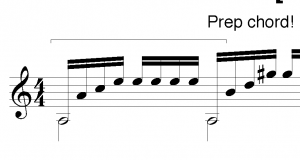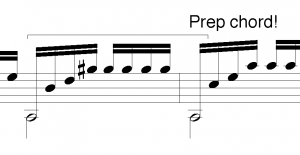Practice Techniques: Chaining
note: click on the images to view larger versions.
One of the most effective ways to learn a piece is practicing small units at tempo, slowing building longer and longer chains of little units. Most of us think of practicing a measure or beat at time, but that is not the way. We need to practice through the beat, incorporating work on the transition between the units while practicing small events.
Take this brief passage from Carcassi’s Op. 60, No. 2.

Each chord change happens on beats one and three. In order to work on the first unit, we’d practice the bracketed section below. To be sure the transition is smooth, as we play beat three we’d move to the upcoming chord on beat three (note: don’t actually play any more than the low A on beat three, merely prep the fingers for the chord).

After that unit is mastered, we’d work from beat three to the downbeat of the next measure. On the downbeat we prepare the chord as we did on beat three in our last step.

With both of the smaller sections mastered, we can reassemble them into a larger unit. If we can execute the bigger unit at tempo without an issue, the practice method worked. If not, more work on the small units may be needed. As with the last step, we’re going to prepare the next chord on the downbeat of the second measure

I’m using this method on Malcolm Arnold’s Fantasy (first movement) to learn some big arpeggios.


Gary Fletcher
Hi, great lesson. Really makes it easy to understand how to go about breaking a piece of music down and put the parts back together again. Thanks for sharing it.
Ethan
Thanks for this tip. My biggest issue is the transition, but this makes it much easier to swallow.